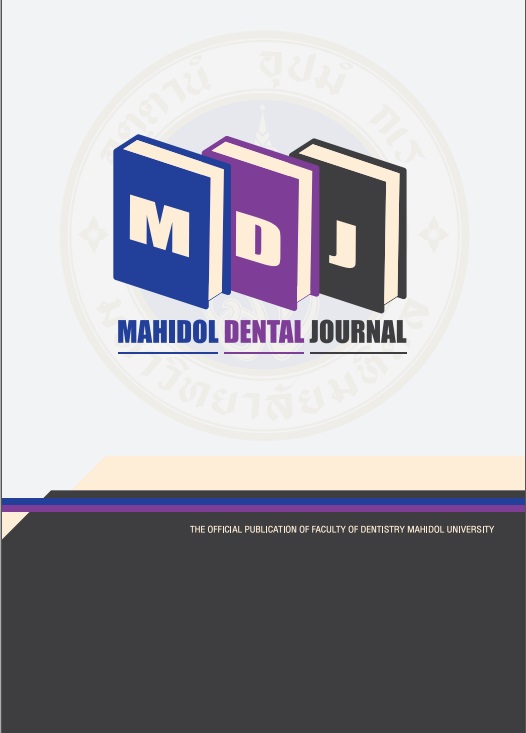Dissemination of the splatter generated during resin-based and glass ionomer sealant application procedures
Main Article Content
Abstract
Objectives: The aim of this study was to compare the dissemination of the splatter generated during resin-based and glass ionomer sealant application procedures.
Materials and Methods: The experiment was conducted on a dental phantom head that was inserted into the head rest of a dental chair and set in a reclined position, mimicking the sealant application procedure routinely performed on a patient. To trace the dissemination of splatter droplets generated during the sealant application procedure, a 0.1% fluorescein dye solution was connected to the dental unit water supply and a 1 x 1 ft2 cotton sheet, with a hole in the middle for the mouth, was placed on the phantom’s head. Resin-based and glass ionomer sealant application procedures were performed on the right and left posterior teeth by four operators. After the sealant application procedure was completed and the fluorescent stain was completely dried, a transparent grid with 0.5x0.5 cm2 squares was placed over the cotton sheet and the number of squares with splatter stain visible through the grid was counted under ultraviolet light by two examiners who were blinded to the treatments. The examiners performed intra- and inter-correlation tests for reliability.
Results: The splatter production varied among the operators. There was no significant difference between the number of contaminated squares generated from the glass ionomer sealant and resin-based sealant application procedures (p>0.05). Moreover, the number of contaminated squares was not significantly different between the two sealant materials’ applications on the same treatment side (p>0.05).
Conclusion: The application process of the resin-based and glass ionomer sealant generated the same level of splatter dissemination.
Article Details

This work is licensed under a Creative Commons Attribution-NonCommercial-NoDerivatives 4.0 International License.
References
Sharma A, Ahmad Farouk I, Lal SK. COVID-19: A Review on the Novel Coronavirus Disease Evolution, Transmission, Detection, Control and Prevention. Viruses 2021; 13: 202.
Wadia R. Transmission routes of COVID-19 in the dental practice. Br Dent J 2020; 228: 595.
Ge ZY, Yang LM, Xia JJ, Fu XH, Zhang YZ. Possible aerosol transmission of COVID-19 and special precautions in dentistry. J Zhejiang Univ Sci B 2020; 21: 361-8.
Harrel SK, Molinari J. Aerosols and splatter in dentistry: a brief review of the literature and infection control implications. J Am Dent Assoc 2004; 135: 429-37.
Veena HR, Mahantesha S, Joseph PA, Patil SR, Patil SH. Dissemination of aerosol and splatter during ultrasonic scaling: a pilot study. J Infect Public Health 2015; 8: 260-5.
Dahlke WO, Cottam MR, Herring MC, Leavitt JM, Ditmyer MM, Walker RS. Evaluation of the spatter-reduction effectiveness of two dry-field isolation techniques. J Am Dent Assoc 2012; 143: 1199-204.
Checchi V, Bellini P, Bencivenni D, Consolo U. COVID-19 Dentistry-Related Aspects: A Literature Overview. Int Dent J 2021; 71: 21-6.
Jaafar N, Ragab H, Abedrahman A, Osman E. Performance of fissure sealants on fully erupted permanent molars with incipient carious lesions: A glass-ionomer-based versus a resin-based sealant. J Dent Res Dent Clin Dent Prospects 2020; 14: 61-7.
Wright JT, Tampi MP, Graham L, Estrich C, Crall JJ, Fontana M, et al. Sealants for preventing and arresting pit-and-fissure occlusal caries in primary and permanent molars: A systematic review of randomized controlled trials-a report of the American Dental Association and the American Academy of Pediatric Dentistry. J Am Dent Assoc 2016; 147: 631-45.e18.
Colombo S, Beretta M. Dental Sealants Part 3: Which material? Efficiency and effectiveness. Eur J Paediatr Dent 2018; 19: 247-9.
Naaman R, El-Housseiny AA, Alamoudi N. The Use of Pit and Fissure Sealants-A Literature Review. Dent J (Basel) 2017; 5: 34.
Yengopal V, Mickenautsch S, Bezerra AC, Leal SC. Caries-preventive effect of glass ionomer and resin-based fissure sealants on permanent teeth: a meta analysis. J Oral Sci 2009; 51: 373-82.
Chen X, Liu X. Clinical comparison of Fuji VII and a resin sealant in children at high and low risk of caries. Dent Mater J 2013; 32: 512-8.
Banakar M, Bagheri Lankarani K, Jafarpour D, Moayedi S, Banakar MH, MohammadSadeghi A. COVID-19 transmission risk and protective protocols in dentistry: a systematic review. BMC Oral Health 2020; 20: 275.
Eden E, Frencken J, Gao S, Horst JA, Innes N. Managing dental caries against the backdrop of COVID-19: approaches to reduce aerosol generation. Br Dent J 2020; 229: 411–16.
Koo TK, Li MY. A Guideline of Selecting and Reporting Intraclass Correlation Coefficients for Reliability Research [published correction appears in J Chiropr Med. 2017 Dec;16:346]. J Chiropr Med 2016; 15: 155-63.
Marmor MF, Ravin JG. Fluorescein Angiography: Insight and Serendipity a Half Century Ago. Arch Ophthalmol 2011; 129: 943–48.
Bentley CD, Burkhart NW, Crawford JJ. Evaluating Spatter And Aerosol Contamination During Dental Procedures. J Am Dent Assoc 1994; 125: 579-84.
Nulty A, Lefkaditis C, Zachrisson P, Van Tonder Q, Yar R. A clinical study measuring dental aerosols with and without a high-volume extraction device. Br Dent J 2020: 1-8.
Koch M, Graetz C. Spray mist reduction by means of a high-volume evacuation system-Results of an experimental study. PLoS One 2021; 16: e0257137.
Tianviwat S, Thitasomakul S. Spreading control on dental sealant procedure: a simulation study. Th Dent Public Health J 2020; 25: 60-71.


